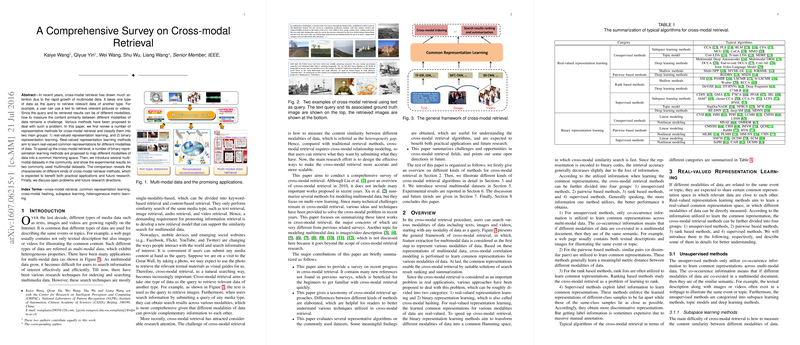A Survey on Cross-modal Retrieval Techniques
Cross-modal retrieval has emerged as a critical area of paper due to the proliferation of multimodal data in contemporary digital ecosystems. This paper offers a comprehensive survey of various strategies in cross-modal retrieval, which is essential for enabling effective information retrieval across diverse data types such as images, text, and videos.
Overview of Cross-modal Retrieval Methods
The paper categorizes cross-modal retrieval methods into two primary groups: real-valued representation learning and binary representation learning, also known as cross-modal hashing. Real-valued representation learning focuses on deriving common continuous representations for diverse modalities, while binary representation learning compresses these representations into binary codes to enhance retrieval speed through hash functions.
Real-valued Representation Learning
Real-valued representation learning approaches are further divided into unsupervised methods, pairwise based methods, rank based methods, and supervised methods. Each category utilizes varying degrees of information, ranging from co-occurrence in unsupervised methods to label-driven constraints in supervised techniques, resulting in more discriminative subspace constructions.
- Unsupervised Methods: These methods rely on co-occurrence data to model latent common spaces. Representative techniques include Canonical Correlation Analysis (CCA) and its variants such as Deep CCA (DCCA).
- Pairwise Based Methods: These methods utilize positive and negative pair information to fine-tune inter-modal metrics, aiming to better align related data from different modalities.
- Rank Based Methods: These approaches model retrieval as a ranking problem, optimizing the ordering of potential matches to align with semantic relevance.
- Supervised Methods: By using known labels, these methods enhance the separability and discriminative power of the learning subspaces. Techniques such as Generalized Multiview Analysis (GMA) and Cross-modal Discriminant Feature Extraction (CDFE) exemplify this category.
Binary Representation Learning
Hashing methods provide efficient retrieval through binary coding schemes. The surveyed work categorizes these methods into linear and nonlinear function modeling, further divided by the nature of supervision:
- Unsupervised Methods: Techniques like Collective Matrix Factorization Hashing (CMFH) use matrix factorization to infer shared binary codes from data across modalities.
- Pairwise Based Methods: These methods, such as Co-Regularized Hashing (CRH), incorporate similar/dissimilar pair information to refine binary code mappings across modalities.
- Supervised Methods: Incorporating label-driven supervision, approaches like Semantic Correlation Maximization (SCM) optimize hashing functions to directly reflect semantic similarities.
Experimental Evaluation
The paper evaluates various cross-modal retrieval methods on datasets such as the Wiki and NUS-WIDE. Results demonstrate the superior performance of supervised learning methods over unsupervised ones, indicating the benefit of leveraging labels for semantic alignment. Additionally, binary representation learning methods like SePH outperform others by effectively preserving semantics in the Hamming space.
Future Research Directions
The paper highlights several avenues for future research:
- Development of large-scale, multimodal datasets to facilitate comprehensive evaluation and training of algorithms.
- Methods to deal with limited and noisy annotations prevalent in real-world multimodal data.
- Scalability and efficiency improvements for handling large datasets.
- Increased application of deep learning techniques for improved feature representation and cross-modal correlations.
- Exploration of finer-level semantic correspondences across modalities, rather than coarse-level common spaces.
Conclusion
Cross-modal retrieval is positioned at the nexus of data integration and retrieval, with a significant impact on enhancing user access to vast multimodal repositories. The surveyed methods underscore a trajectory towards more nuanced, scalable, and semantically aligned retrieval systems. As the field continues to grow, these insights will be pivotal in shaping next-generation solutions.
